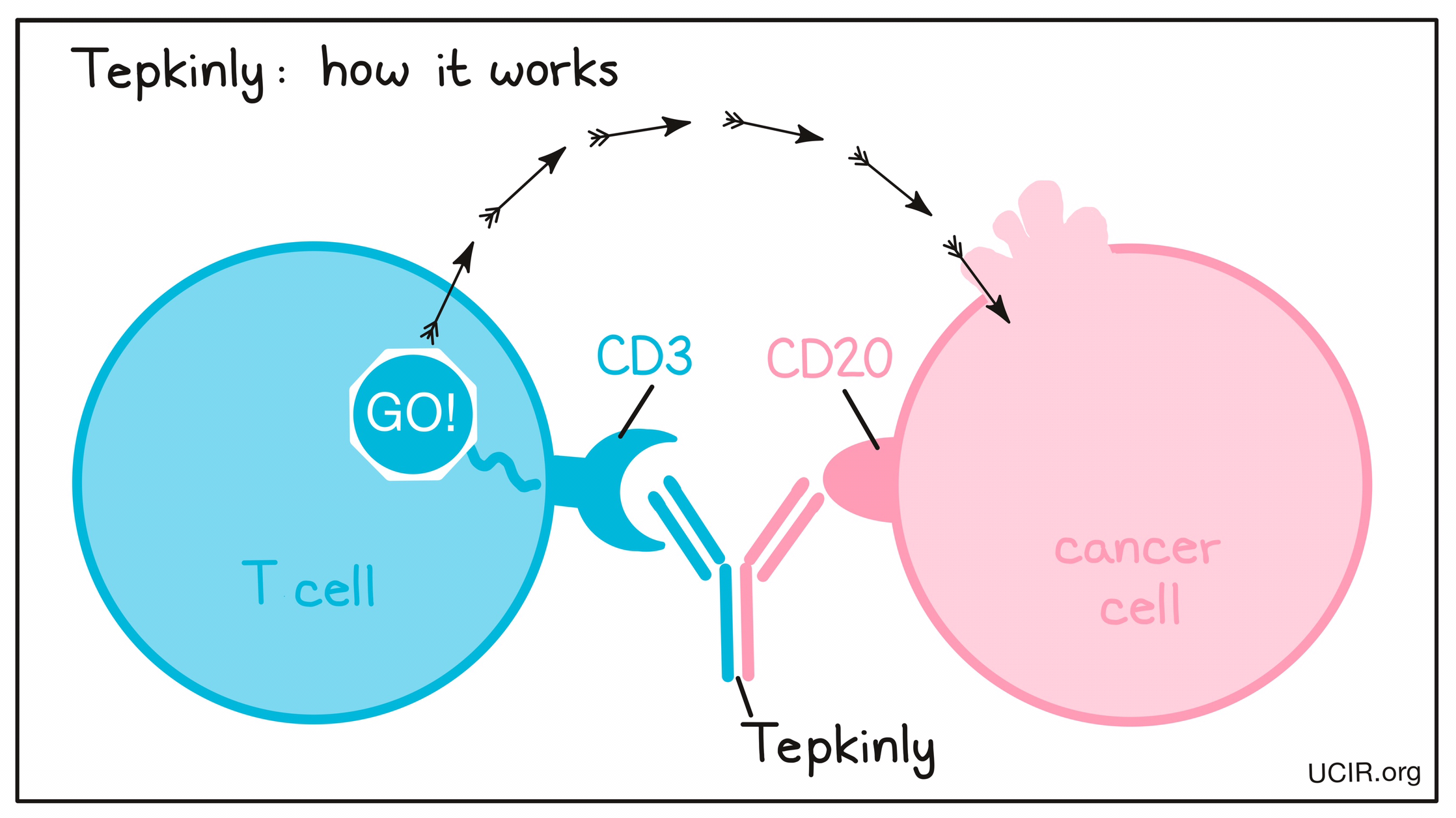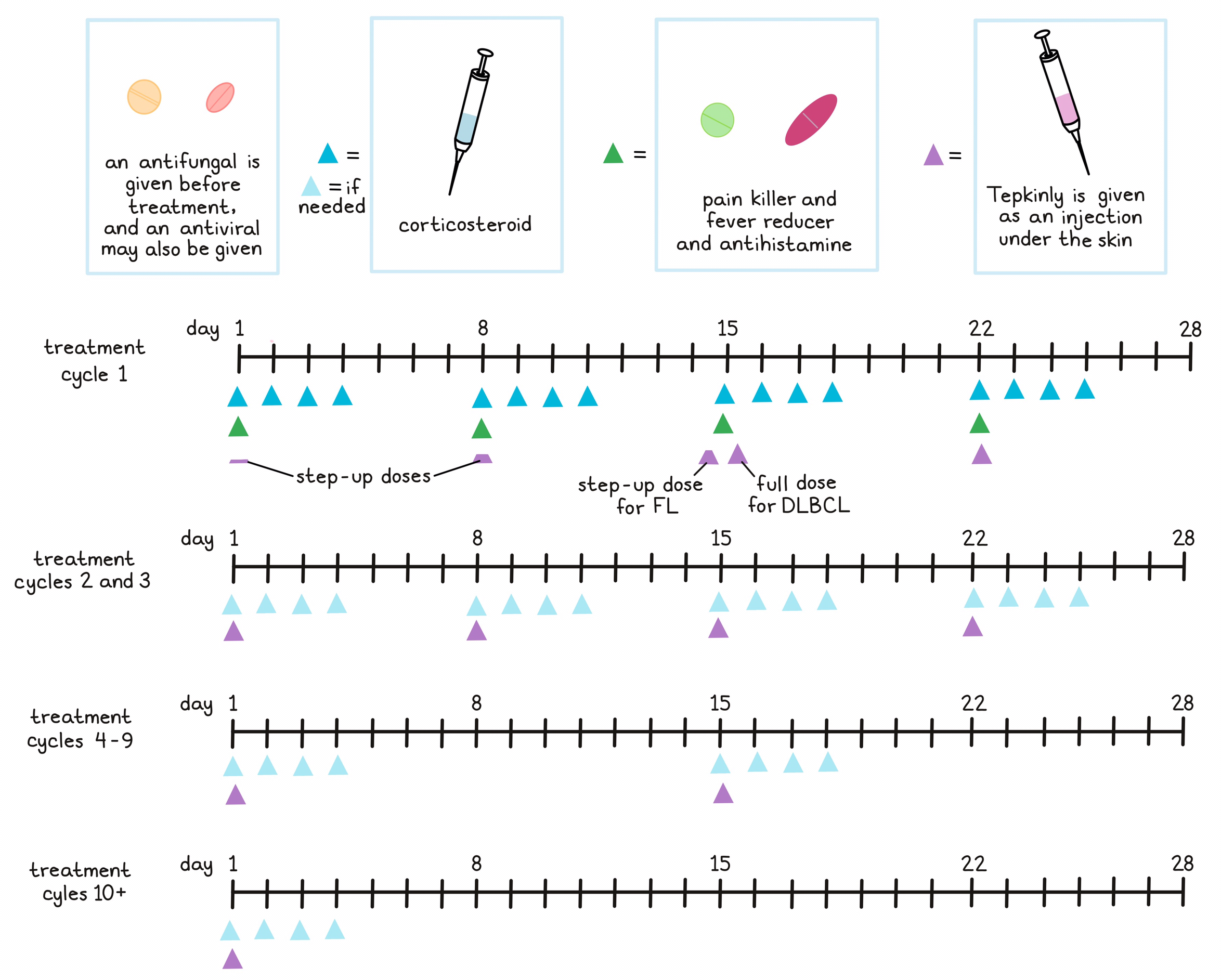Approval in the U.S.
The U.S. product name for Tepkinly is Epkinly
How is this drug name pronounced?
Epcoritamab: EP-koh-RIH-tah-mab
Tepkinly: Tep-KIN-lee
What cancer(s) does this drug treat?
Diffuse large B cell lymphoma (DLBCL)
Tepkinly is approved for:
- Patients with diffuse large B-cell lymphoma (DLBCL) who have received at least two prior systemic treatments for their disease, but whose cancer either did not respond to treatment (refractory) or has since come back (relapsed).
Follicular lymphoma (FL)
Tepkinly is approved for:
- Patients with follicular lymphoma who have received at least two prior systemic systemic treatments for their disease, but whose cancer either did not respond to treatment (refractory) or has since come back (relapsed).
Limitations of use
Limitations: Tepkinly should only be administered in a treatment center and by adequately trained healthcare professionals who can ensure proper monitoring and immediate management of side effects associated with the drug.
Age: The safety and efficacy of Tepkinly in patients under 18 years of age have not been established.
Pregnancy/Breastfeeding: Tepkinly is not recommended for use during pregnancy due to potential for harm to the fetus. Patients who could become pregnant are advised to use contraception during treatment with Tepkinly and for at least 4 months after the last dose of Tepkinly. The risks associated with Tepkinly during breastfeeding are not known and cannot be ruled out. Due to the potential for adverse reactions in the breastfed child, patients are advised not to breastfeed during treatment with Tepkinly and for at least 4 months after the last dose of Tepkinly.
Vaccination: Patients should not be treated with live or live-attenuated vaccines during treatment with Tepkinly.
Interactions with other drugs: Dose adjustments may become necessary for patients treated with certain CYP substrates at the start of treatment with Tepkinly.
Driving and operating machinery: If neurologic symptoms occur, patients should refrain from driving or operating heavy or potentially dangerous machinery until their neurological symptoms resolve.
What type of immunotherapy is this?
- Bispecific antibody therapy
How does this drug work?
Targets:
- CD20 on lymphoma cells and B cells
- CD3 receptor on T cells
Tepkinly is a “bispecific antibody”. Antibodies are molecules that can bind to a particular target molecule. Bispecific antibodies are artificially made in the laboratory and can bind to two different targets at the same time. Tepkinly binds to:
- a molecule called CD20 on the surface of lymphoma cells and some healthy B cells. CD20 is present at much higher quantities on the surface of cancer cells than normal healthy cells.
- a molecule called CD3 on the surface of T cells – the primary immune cells involved in killing cancer cells. CD3 is part of the T cell receptor, which is critical to the function of the T cell and is involved in stimulating the T cell to become active.
Because Tepkinly can bind to one molecule on lymphoma cells and another on T cells at the same time, it acts as a bridge and keeps the T cell in close contact with the cancer cell. By binding CD3 on the T cell, Tepkinly also stimulates the T cell to become activated and kill the cell it is bound to. Bispecific antibodies that direct T cells to kill cancer cells by binding to both cells at the same time are known as bispecific T cell engagers (BiTEs).

How is the drug given to the patient?
Patients receive antifungal medication prior to starting treatment with Tepkinly to prevent a certain form of pneumonia, and may receive antiviral medication to prevent herpes zoster (shingles) reactivation. About 2 hours to 30 minutes prior to receiving each dose of Tepkinly in treatment cycle 1, patients receive several medications to help reduce the risk of cytokine release syndrome:
- A corticosteroid (prednisolone or dexamethasone)
- An antihistamine (diphenhydramine)
- A painkiller and fever reducer (paracetamol)
In addition, the corticosteroid is given for three consecutive days following each dose of Tepkinly in treatment cycle 1 and, if needed, 2 hours to 30 minutes before Tepkinly administration and for three consecutive days following Tepkinly administration in subsequent treatment cycles.
Patients should be well hydrated before they receive Tepkinly, which is administered via an injection under the skin (subcutaneous injection) of the lower part of the abdomen or the thigh. During the first treatment cycle (a 28-day period), patients with diffuse large B-cell lymphoma (DLBCL) are treated with “step-up doses”, with a low dose of Tepkinly on day 1, a slightly higher dose on day 8, and a full dose of Tepkinly on day 15 and day 22. Similarly, patients with follicular lymphoma (FL) receive step-up doses of Tepkinly on days 1, 8, and 15, and then receive their first full dose of Tepkinly on day 22 . During the second and third treatment cycles, all patients receive a full dose of Tepkinly on days 1, 8, 15, and 22. During treatment cycles 4 to 9, a full dose of Tepkinly is administered on days 1 and 15. For every subsequent treatment cycle, a full dose of Tepkinly is given on day 1 only.

What are the observed clinical results?
It is important to keep in mind that each patient’s outcome is individual and may be different from the results found in the clinical studies.
Diffuse large B cell lymphoma
In a clinical study, 139 patients with diffuse large B-cell lymphoma who had received at least two prior treatments for their disease, but whose cancer either did not respond to treatment or had since come back, were treated with Tepkinly. At a median follow-up of 16 months:

(For a definition of median click HERE.)
Follicular lymphoma (FL)
In a clinical study, 128 patients with follicular lymphoma that did not respond or came back after 2 or more prior systemic treatments were treated with Tepkinly. At a median follow-up of 16 months:

What are the potential side effects?
Tepkinly targets CD20, which, while present on lymphoma cells, is also present on some normal B cells. As a result, Tepkinly can also kill normal B cells, increasing the risk of serious infections. Other common side effects of Tepkinly include cytokine release syndrome, injection site reactions, fatigue, low immune cell counts (neutropenia), pain in the muscles, joints, and bones, fever, and diarrhea.
Some side effects, such as cytokine release syndrome, infections, immune effector cell-associated neurotoxicity syndrome, tumor lysis syndrome, and tumor flare can become serious or life-threatening. Patients and caregivers receive careful instructions to monitor for signs and symptoms of side effects. These conditions are managed by the healthcare provider.
Cytokine release syndrome (CRS) CRS is caused by a widespread release of molecules called cytokines, which can cause inflammation and can affect the function of various organs. Cytokines may be released by the T cells to which Tepkinly binds, or by other immune cells in the patient’s body. Signs and symptoms of CRS include fever, low blood pressure, hypoxia (low oxygen levels), fast heartbeat rate, shortness of breath, and chills. CRS typically occurs within 24 hours after the most recent dose of Tepkinly in treatment cycle 1. A healthcare provider should be immediately notified if symptoms occur.
Immune effector cell-associated neurotoxicity syndrome (ICANS) Some of the cytokines released during CRS can result in disruption of the blood–brain barrier, leading to the development of neurological toxicities. ICANS typically occurs within 3 days after the most recent dose of Tepkinly in treatment cycle 1. Symptoms of ICANS include shaking, lethargy, seizures, confusion, and difficulty with speech or handwriting. A healthcare provider should be immediately notified if symptoms occur.
Infections Tepkinly can alter the immune system, leaving patients more vulnerable to infections. Severe, life-threatening, or fatal infections have been reported in patients receiving Tepkinly.
Tumor Lysis Syndrome (TLS) TLS is caused by the rapid breakdown of cancer cells. TLS can cause kidney failure and abnormal heart rhythms. Symptoms of TLS include nausea, vomiting, diarrhea, and lethargy.
Tumor flare Tumor flare is a transient growth of the tumor or worsening of tumor-related problems, likely due to the influx of immune cells to the tumor site. This can cause swelling or pain at the sites of tumor lesions, which may cause problems if the increased size of the tumor puts pressure on nearby airways or vital organs.
For a more complete list of possible side effects, see the full prescribing information.
Additional information
Manufacturer
AbbVie
Approval
FDA (Drug name: Epkinly) and EMA
Links to drug websites
Last updated: October 10, 2025


